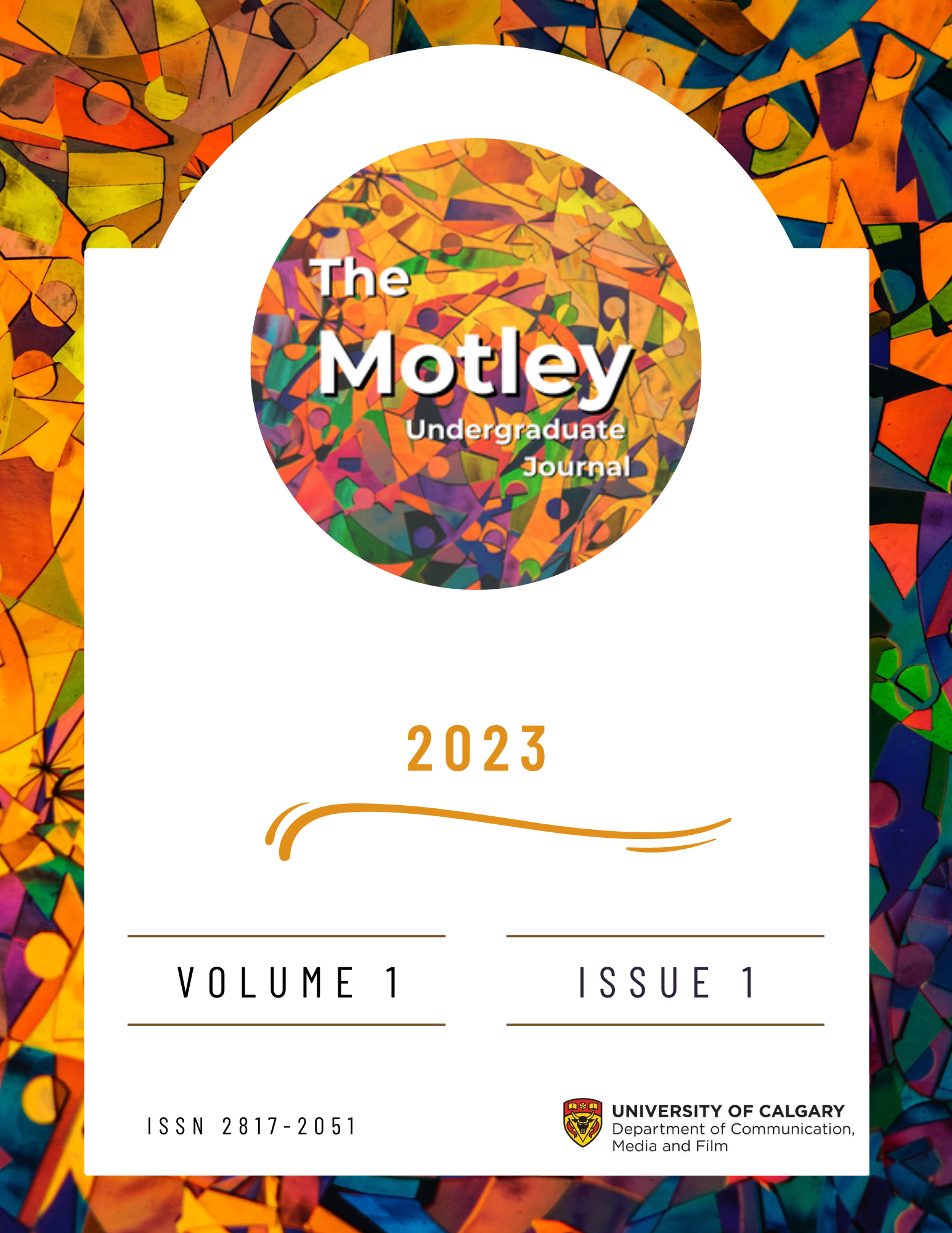The Contemporary aesthetics of adolescence
How Euphoria uses style to spectacularize representation of modern youth in the articulation of a teenage gaze
DOI:
https://doi.org/10.55016/ojs/muj.v1i1.76165Keywords:
teenage gaze, aesthetic pretensions, performance, teenage image, EuphoriaAbstract
The release of the second series of the HBO hit television series Euphoria was met with large popular culture criticism of the stylization of the teenage experience. In this analysis the method of visual rhetorical analysis is used to demonstrate how visual elements of the television series Euphoria, in its performance, communicates ideas about how Euphoria prescribes audiences a certain way of viewing the experiences of adolescence in a thematically significant way, producing a ‘teenage gaze.’ Euphoria relies on a heavily stylized manifestation of mature themes, described by critics as aesthetic pretensions, to convey a sense of performance that is well suited to the visual rhetorical analysis of color and light, aesthetics of technology, fashion, and setting (Vanity Fair, 2021). This analysis expands on how these visual elements contribute to spectacularized performance, supported by commercial adoption of the teenage image and experience that is oppressive in the othering of real teens and their authentic experiences. In addition to deconstructing spectacle, this analysis focuses on the role of liminality in the visuals presented by Euphoria, and how they negotiate visual and thematic boundaries to produce nostalgia, an essential element of the teenage gaze. The evolution of the teenage gaze, and its study in popular culture contexts, is significant when considering the current sociopolitical environment where youth are often marginalized in the face of crisis. This study of visual rhetoric in Euphoria finds that through the articulation of the teenage gaze amongst mature Euphoria viewers and producers, the teenage experience is assimilated into mainstream culture by a media industry that can force experience into oblivion through stylized, aesthetic representation.
References
Akass, K., & McCabe, J. (2018). HBO and the Aristocracy of Contemporary TV Culture: affiliations and legitimatising television culture, post-2007. Mise Au Point, (10), 1-11. https://doi.org/10.4000/map.2472.
Amiwala, B. (2020, October 14). Engaging Young People in Politics. PBS. https://www.pbs.org/education/blog/engaging-young-people-in-politics.
Berman, J. (2022, May 18). Welcome to the Era of Unapologetic Bad Taste. TIME. https://time.com/6176272/bad-taste-pop-culture-summer-2022/.
Bhatt, D. (2022, January 27). Decoding every outfit on season 2 of Euphoria. Vogue. https://www.vogue.in/fashion/content/decoding-every-outfit-on-season-2-of-euphoria.
Debord, G. (1994). La Société du Spectacle (D. Nicholson Smith, Trans.). Zone Books. (Original work published 1967).
De Klerk, A. (2022, March 9). The Euphoria cast members were the real stars of fashion month. Harper's Bazaar. https://www.harpersbazaar.com/uk/fashion/fashion-news/a39221810/euphoria-fashion-week/.
Chen, E. (n.d.1). [Kat on Bathroom Floor]. [Photograph]. i-d Magazine. https://i-d.vice.com/en/article/wxd78y/euphoria-bts-photos-eddy-chen.
Chen, E. (n.d.2). [Light Leaks 1]. [Photograph]. Eddy Chen Photography.
http://www.eddychenphotography.com/g0hu2x2cr1xz1lsr9p8d1wbsnr5lp3.
Chen, E. (n.d.3). [Light Leaks 2]. [Photograph]. Eddy Chen Photography. http://www.eddychenphotography.com/kpov58j6nkphwfxfssh6ji20oqf1iy.
Chen, E. (n.d.4). [Rue in Natural Light] [Photograph]. Eddy Chen Photography. http://www.eddychenphotography.com/rujlrkbdikdw95jnitdpbrkkhfgzsv.
Chen, E. (n.d.5). [Maddie, Cassie, Kat, Fashion] [Photograph]. i-D Magazine. https://i-d.vice.com/en/article/wxd78y/euphoria-bts-photos-eddy-chen.
Chen, E. (n.d.6). [Kat in Red]. [Photograph]. i-d Magazine. https://i-d.vice.com/en/article/wxd78y/euphoria-bts-photos-eddy-chen.
Chen, E. (n.d.7). [Rue in Holy Addiction]. [Photograph]. Eddy Chen Photography.
http://www.eddychenphotography.com/q3vl1jgob8pvu9z92lwsvl4obqju1n.
Elgenaidi, D. (n.d.). Why Are Teen TV Shows Getting Darker and Darker? Nylon. https://www.nylon.com/teen-television-dark-riverdale-sabrina.
Esquire Editors. (2022, January 20). ‘Euphoria’ Isn’t About Gen Z. It’s A Fantasy Revision of High School for Millennials. Esquire. https://www.esquire.com/uk/culture/tv/a38799020/euphoria-high-memes-gen-z-sex-scenes-season-2/.
Foss, S. (2004). Theory of Visual Rhetoric. In Barbatsis, G., & Kenney, K., & Moriarty, S., & Smith, K. (Eds.), Handbook of Visual Communication: Theory, Methods, and Media. (pp. 141-152). Taylor and Francis. https://doi.org/10.4324/9781410611581.
Reinhardt, J. (n.d.). gaze. The Chicago School of Media Theory. https://lucian.uchicago.edu/blogs/mediatheory/keywords/gaze/.
Gries, L. (2020). Advances in Visual Rhetorical Analysis. In Pauwels, L., & Mannay, D. (Eds.), The SAGE Handbook of Visual Research Methods. (pp. 381-396). SAGE Publications, Inc. https://dx.doi.org/10.4135/9781526417015.
HBO. (n.d.1). [Kat’s Bedroom]. [Photograph]. House Beautiful. https://www.housebeautiful.com/shopping/homeaccessories/a39228634/euphoria-characters-beds/.
HBO. (n.d.2). [Cassie’s Pink Bedroom]. [Photograph]. House Beautiful. https://www.housebeautiful.com/shopping/homeaccessories/a39228634/euphoria-characters-beds/.
Kodak. (2022, April 1). Marcell Rév adopts an EKTACHROME approach for 'Euphoria' in pursuit of a nostalgic view. https://www.kodak.com/en/motion/blog-post/euphoria.
Lawson, R. (2022, January 9). Euphoria Season 2 Is Too Stylish for Its Own Good. Vanity Fair. https://www.vanityfair.com/hollywood/2022/01/euphoria-season-2-is-too-stylish-for-its-own-good.
Longaker, M., G. & Walker, J. (2011). Rhetorical Analysis: A Brief Guide for Writers. Pearson.
Moore, B. (2022, September 2). The ‘Euphoria’ Effect Is Turning Costume Designers Into The Next Influencers. Womens Wear Daily.
Mulvey, L. (1992). Visual Pleasure and Narrative Cinema. In Braudy, L., & Cohen, M., & Mast, G. (Eds.), Film Theory and Criticism: Introductory Readings. (pp, 746-757). Oxford University Press. (Original work published 1975).
Olin, M. (1996). Gaze. In Nelson, R. & Shiff, R. (Eds.), Critical Theories for Art History. (pp. 318-329). University of Chicago Press.
Picchio, A. (n.d.). The Euphoria Effect: The HBO TV Show That Has Become A Fashion Inspo For Gen Zers. New Wave Magazine.
Rose, G. (2016). Visual methodologies: An introduction to researching with visual materials. SAGE Publications.
Spangler, T. (2022, February 25). ‘Euphoria’ Is The Most Tweeted TV Show of the Decade (So Far), Twitter Says. Variety. https://variety.com/2022/digital/news/euphoria-most-tweeted-tv-show-1235190599/.
Turner, V. (2002). Liminality and Communitas. In Lambek, M. (Ed.), A Reader in the Anthropology of Religion. (pp. 358-374). Wiley Blackwell Publishing. (Original work published 1969).
UNICEF (n.d.). The impact of COVID-19 on the mental health of adolescents and youth. https://www.unicef.org/lac/en/impact-covid-19-mental-health-adolescents-and-youth.
United Nations (2013). Youth, Political Participation and Decision Making. https://www.un.org/esa/socdev/documents/youth/fact-sheets/youth-political-participation.pdf.
Downloads
Published
How to Cite
Issue
Section
License
Copyright (c) 2023 Lana Coles

This work is licensed under a Creative Commons Attribution-ShareAlike 4.0 International License.
Copyright Policy
The Motley Undergraduate Journal is an Open Access article distributed under the terms of the Creative Commons Attribution 4.0 Share-Alike License. Under this license, users are free to share (copy, distribute and transmit) and remix (adapt) the contribution, including for commercial purposes, providing that the original work is properly cited. Under Creative Commons, authors retain copyright in their articles.
Author Self Archiving Policy
Authors are permitted to post their work online in institutional/disciplinary repositories or on their own websites. Pre-print versions posted online should include a citation and link to the final published version in The Motley Undergraduate Journal as soon as the issue is available; post-print versions (including the final publisher's PDF) should include a citation and link to the journal's website.

